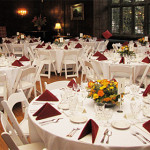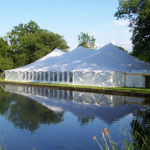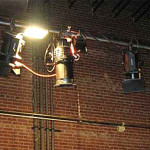 When hosting an informative or conference type event, there’s really nothing worse than watching your audience slip into a comatose state while you’re speaking or presenting. Like any seasoned public speaker will tell you, the trick to keeping them in … Continue reading
When hosting an informative or conference type event, there’s really nothing worse than watching your audience slip into a comatose state while you’re speaking or presenting. Like any seasoned public speaker will tell you, the trick to keeping them in … Continue reading
The post 8 Tips for Keeping an Audience Engaged appeared first on Event Focus.
]]>- Use quick quizzes throughout to test their knowledge. A random questionnaire or quiz is also an excellent way to slip in a little subtle bragging and feed your audience new information that you might not be able to deliver through your speech or presentation – for instance “by what percentage did our client base grow in 2012?”
- Set mini tasks for your audience to complete. No audience member goes to an event or conference to yawn their way through a stack of slides – they want to participate! While challenging them, you can also utilise the opportunity to harvest new ideas and inspiration for your business or project.
- Have posters printed with a unique Twitter hash tag for your event and set up a projector through which the Twitter feed will be displayed. Before long, your audience will be having conversations with each other via the screen! What’s more, because Twitter is public, your event will get that much more exposure throughout – how’s that for Marketing 101?
- Get feedback through constant surveys. Whether they vote with their phones, through a social network, with pen and paper or custom voting devices, surveys are a fantastic way to make your audience feel like their opinion truly matters. And it’s a golden opportunity to capture valuable data and insights!
- Let your audience interact with each other through group tasks and discussions. Not only will this break the ice, but you’ll find that through the sharing of opinions, the audience members become more fired up about what it is that you’re presenting.
- Allow time for questions – not just at the end of the event, but at various intervals. By answering your audience’s questions throughout, you can keep track of what they’re thinking as well as keep them from overthinking matters that you don’t necessarily want them to wonder about too much.
- Keep your content riveting and interesting. Don’t fall into a rut and present your entire speech in bullet point form or as infographics – shake things up! And when the moment calls for it, pop an appropriate joke in the mix or tell a little personal experience story.
- Have mini giveaways throughout the event! If there’s one thing everyone loves, it’s winning something, and by something we mean anything from a branded pen to a book or a brand new tablet.
Photo Credit : kcotterill.wordpress.com
The post 8 Tips for Keeping an Audience Engaged appeared first on Event Focus.
]]> When organising a big event, it’s never a bad idea to assemble a committee to help organise the event and make it a reality. The structure of an event committee might vary from event to event, depending on what the … Continue reading
When organising a big event, it’s never a bad idea to assemble a committee to help organise the event and make it a reality. The structure of an event committee might vary from event to event, depending on what the … Continue reading
The post The Event Committee { Who’s who? } appeared first on Event Focus.
]]>When organising a big event, it’s never a bad idea to assemble a committee to help organise the event and make it a reality. The structure of an event committee might vary from event to event, depending on what the needs and requirements are, but here follows a basic breakdown of the key members of the team:
Chairperson: Just like the CEO of a company, the chairperson is the most important person in the mix, overseeing the operation and organisation of the event from start to finish. It’s usually the chairperson’s job to make a speech and represent the committee at the actual event.
Treasurer: This is by far one of the most important pairs of shoes to fill, as this person will be responsible for keeping track of the money. The treasurer needs to be very responsible with good morals, and should ensure that all teams stay within the budget, holding every member financially accountable.
Project Manager: From scheduling committee meetings and basic admin to taking minutes at the meeting and working out the timeline – the project manager is the main brain that holds everything together. Generally all other teams and committee members will work via the project manager, keeping him/her up to speed of where things are at so that said manager can ensure that everything happens when it’s supposed to.
Sponsorship and Fundraising: This person or group is responsible for sourcing sponsorship and doing fundraising projects, as well as approaching companies for financial support – generally in the case of a charity event. Duties can include: Harvesting food donations for the event, getting prizes for auctions and raffles, acquiring endorsements from companies, and doing whatever it takes to generate funding for the charity event.
Marketing, PR and Communications: As the official spokesperson for the event, the person in charge of PR and Marketing should communicate with the media and public in order to generate hype around the event. What’s more, this role also involves overseeing the design of the website, brochures, goodie bags, program booklets, T-shirts, pens and any other promotional items. While traditional advertising like newspapers and radio is a good starting platform, online channels like social media sites and blogs are excellent ways of promoting an event.
Logistics: From organising the catering and getting council permits to finalising sound and lighting and coordinating the setup – the logistics manager and his team essentially ensure that things get done. While other “departments” might have the creative vision, the logistics guys get the job done, sorting through the nitty-gritty to make sure that the event goes off without a hitch.
Volunteer Management: Especially for charity events, volunteers can play an extremely valuable role in practical respects. The volunteer manager is therefore responsible for looking after the volunteers, from recruitment phase right through to training and assigning jobs.
Technical: While every event doesn’t require a full-on technical team, you really can’t go wrong with having one on board. The technical gurus can be responsible for building the website (if required) as well as sorting out lighting and audio visual equipment for the event.
Photo Credit: veronicagold.info
The post The Event Committee { Who’s who? } appeared first on Event Focus.
]]> Hiring a venue isn’t as simple as looking, touring and booking, and if you’re not careful you can fall victim to a multitude of hidden costs and clauses. Make sure you ask the right questions to avoid any post-party run-ins … Continue reading
Hiring a venue isn’t as simple as looking, touring and booking, and if you’re not careful you can fall victim to a multitude of hidden costs and clauses. Make sure you ask the right questions to avoid any post-party run-ins … Continue reading
The post Questions to Ask: The Venue Manager appeared first on Event Focus.
]]>Hiring a venue isn’t as simple as looking, touring and booking, and if you’re not careful you can fall victim to a multitude of hidden costs and clauses. Make sure you ask the right questions to avoid any post-party run-ins with the venue manager:
- What is the maximum number of guests that the particular room or venue can accommodate, with and without a dance floor?
- What is the basic venue usage fee?
- What is included in the venue usage fee, and what isn’t?
- If I rent the venue for the aforementioned price, what are the hours that the room will be at my disposal?
- What is your overtime fee?
- What is your policy on hiring outside catering or using the on-site caterer?
- Is there a kitchen available and, if so, is the use thereof included in the venue fee?
- Does the venue have a liquor licence?
- Is there a fully stocked bar which we can utilise for the event, and if so, what are the additional costs involved? (Hiring, barmen, ice, etc.)
- What is your corkage fee?
- What is your breakage fee?
- Tell me about the staff – how many staff members are included, how much is their overtime fee and what should I know before using them for my event?
- Is there any sound and video equipment available and, if so, what will the additional usage fee be?
- Do you have a “no noise after x o’clock” policy?
- Do you require a security deposit? If so, how much is it and when will it be returned to me?
- What do you need from me in order to book the space? I.e. deposit, documentation, etc.
- Do you have a setup and cleaning crew? If so, what will the cost be to hire them before and after the event?
- By what time should the venue be evacuated, and by what time the next morning should it be clean?
- From what time will the vendors and setup crew have access to the event space prior to the actual event? If there’s no event the night before, can we come in then already?
- What type of chairs and tables do you have on-site – round, rectangular, cocktail, etc.?
- Are there any restrictions in terms of décor and setup? For instance, can we hang decorations from the ceiling or walls?
- Will the venue be hosting any other events on the same day? And if so, how will that impact my event?
- Do you have samples of linens, chandeliers and all other elements that are included in the venue price, which I can view?
- You have experience with venue layout – in your opinion, what is the best way to make the most of this space?
- Can you mock-up a diagram of the room based on my preliminary head count?
- How do the parking facilities work? How much space is available and is there a security guard on-site?
- Do you have pictures of past events that I can have a look at?
- Can we have a tour of the facility when it is set up for an event?
Photo Credit: www.onefabday.com
The post Questions to Ask: The Venue Manager appeared first on Event Focus.
]]> DO: Assign a seat or table to each of your guests – while you might like the idea of guests choosing their own seats, the reality is that no guest wants to scramble for a spot. DON’T: Feel obligated to … Continue reading
DO: Assign a seat or table to each of your guests – while you might like the idea of guests choosing their own seats, the reality is that no guest wants to scramble for a spot. DON’T: Feel obligated to … Continue reading
The post Table Plan Dos and Don’ts appeared first on Event Focus.
]]>DO: Assign a seat or table to each of your guests – while you might like the idea of guests choosing their own seats, the reality is that no guest wants to scramble for a spot.
DON’T: Feel obligated to have designated seats – assigning guests to tables is more than acceptable too.
DO: Place friends, couples and colleagues at the same table – guests will notice if you try to seat strangers together with the hopes of them getting to know each other.
DON’T: Place all the “leftover” or “odd” people at one table – rather mix them in with the rest so that they don’t feel awkward or too out of place.
DON’T: Place elderly guests near the loud speakers.
DO: Place them close to the restroom yet still in close proximity to the stage so that they can hear what’s being said.
DON’T: Leave the seating plan until the very last minute – it takes great time and effort to iron out the wrinkles.
DO: Supply your venue with the seating plan a week or so beforehand so that they can determine the exact floor layout.
DO: Use a large and legible typeface for your seating plan so guests can read it from afar, and consider printing two copies of the plan so they don’t have to crowd around one stand.
DON’T: Rely solely on place cards to guide your guests, and don’t place the seating plan somewhere in a corner where guests have to go and hunt for it.
DON’T: Seat all the vegetarians, vegans or guests who chose the same menu option at the same table just to make it easier for your waiting staff.
DO: Make a small mark on each place card (using coloured stickers or ribbons) to indicate which menu option that guest has chosen.
DO: Consider appointing an usher to show guests to their seats.
DON’T: Make the table numbers (on the tables) so small that guests have to walk right up to each table to see if it’s theirs or not.
DO: Leave a space the size of two chairs at the table for a guest in a wheelchair.
DON’T: Leave less than 1.5 m space between chair backs (when chairs are pushed in under the tables) – rather leave too much space to allow guests to move freely between the tables.
DO: Use rectangular tables if you want to save space, save on table decorations or generate more conversation around the tables.
DON’T: Seat your guests on all sides of the rectangular table if they’re expected to turn their attention to the stage area for most of the event.
DON’T: Place more than 12 people around a round table as it can get quite cluttered.
The post Table Plan Dos and Don’ts appeared first on Event Focus.
]]> As simple and trivial as they might seem, name tags are crucial to the success of your event – in fact, in many corporate circles, a messed up name tag can be considered a personal offence. So before you dive … Continue reading
As simple and trivial as they might seem, name tags are crucial to the success of your event – in fact, in many corporate circles, a messed up name tag can be considered a personal offence. So before you dive … Continue reading
The post The Ins and Outs of Name Tags appeared first on Event Focus.
]]>As simple and trivial as they might seem, name tags are crucial to the success of your event – in fact, in many corporate circles, a messed up name tag can be considered a personal offence. So before you dive in head first, here are a couple of tips to bear in mind when printing and planning your name tags:
- Get your guest list sorted as soon as humanly possible and make sure you don’t leave a single name out when printing the name tags. There’s no better way to alienate a guest from than by neglecting to provide him/her with an official name tag.
- If you’re planning a formal event, consider magnetic name tags as opposed to pins – the insight being that most ladies aren’t charmed with the idea of piercing their beautiful gowns with pins.
- Feel free to leave off titles like Mr or Mrs, however in the case of a doctor or military officer it’s always respectful to add their title to the name tag.
- Should you wish to add titles or company names (e.g. Chairman, Peter’s Pizza), be sure to find out what your guests’ exact titles are – weeks in advance already! Getting titles wrong can reflect poorly on you and ultimately upset your guests, so don’t leave this until the last minute.
- If you’re going with lanyards (i.e. name tags on neck bands), bear in mind that the tag will swing and twist around. Hence it’s best to have two copies of each name tag printed so that you can insert it back to back.
- Choose a font that’s easy to read – in other words, avoid curly or elaborate typefaces and light colours that force guests to climb into each other’s personal space.
- In terms of size, opt for anything between 24 and 36 points so that even short-sighted guests can get to know one another. If you’re placing both name and title on the cards, make the name bigger (approx. 36 pt.) and the title smaller (approx. 26 pt.)
- The standard name tag size for a cocktail party is approximately 5 x 7,5cm whereas conference badges should be no smaller than 10 x 7,5cm.
- Send the artwork to your printer at least a week or two in advance so that they can do a test print – the last thing you need is the stress of misprinted name tags on the day. Final tags should be printed no less than two days before the event.
- Order extra blank tags so that your assistant can make handwritten tags, should unexpected guests arrive. While the tags won’t look exactly the same, the fact that you can provide them with a tag will make them feel right at home.
- Set up the tag table close to the entrance so that your guests don’t have to go hunting for a tag. Aside from the tags, make sure the person responsible has a printed copy of the guest list so that he/she can tick off the names as they arrive.
- If you’re expecting media or press (whose names and titles you’re unsure of), print a stack of generic badges so that they can easily be identified – better yet, use a different colour paper for their tags.
- Whether you’re using name tag holders or simply popping a pin on the back, DON’T leave it until the day of the event. Even though it seems like a small and trivial task, it can be quite cumbersome and time consuming.
Image Credit: EHow.com
The post The Ins and Outs of Name Tags appeared first on Event Focus.
]]> Outdoor events are spectacular, especially since the vast open space is so much less restricting than an existing venue structure. However with great potential comes great responsibility, so be sure to follow these tips to pull of your outdoor event … Continue reading
Outdoor events are spectacular, especially since the vast open space is so much less restricting than an existing venue structure. However with great potential comes great responsibility, so be sure to follow these tips to pull of your outdoor event … Continue reading
The post 25 Tips for Hosting an Outdoor Event appeared first on Event Focus.
]]>Outdoor events are spectacular, especially since the vast open space is so much less restricting than an existing venue structure. However with great potential comes great responsibility, so be sure to follow these tips to pull of your outdoor event with a bang:
- Find out if you need a permit to host the event at that particular place/venue. If you do, then be sure to get one – ASAP.
- Phone the venue management/local authorities and find out what the rules are – is noise prohibited, can you decorate the trees, may ladies wear heels, etc.
- Make sure that there are bathroom facilities available – if not, hire the required number. As a rule of thumb, two restrooms per 100 guests should do the trick.
- Make the necessary arrangements for electricity supply and extension cords. As an extra precaution, have a generator on standby and be sure to secure all cords to the ground to reduce tripping hazards.
- Hire security guards to safeguard the area and parking lot.
- Judge the available lighting and bring in a lighting specialist if it’s not sufficient.
- Map out the available space on a piece of paper and clearly mark where everything will be set up. This plan should be sent to all vendors and people involved.
- On the morning of the event, mark out the various areas with chalk dust so that vendors know exactly where to set up.
- Check whether the ground is level enough for tables and chairs to stand securely – especially buffet tables, as the heavy platters are more likely to slip off.
- Drinks are essential for an outdoor event, so make sure you boost the order to keep your guests hydrated.
- Find out what type of equipment and amenities your caterer will require and make the necessary arrangements.
- Because there are no walls against which to set up stations like the bar and DJ table, do think of ways in which to conceal the unsightly areas from behind.
- Bring in an exterminator to debug the area so that your food or guests aren’t attacked by pests. Alternatively light citronella candles, cover the food and keep repellent at hand.
- Make sure that the area is accessible to disabled people – whether you appoint an extra hand to assist them or lay temporary flooring in areas for them to navigate along.
- Set out enough bins so that guests aren’t left standing with dirty napkins in their hands.
- Make sure there are plenty of shaded and sheltered areas for guests to retire to.
- Ensure your guests’ comfort by supplying them with hand wipes, umbrellas, fans, sunblock, blankets or insect repellent.
- If the area is quite far out of town, be sure to have medical staff or a first aid kit handy.
- Have a Plan B ready in case of an unexpected weather change – don’t just consider rain, but also wind and harsh sunlight.
- Be sure to inform your guests that it is an outdoor event so that they can dress accordingly.
- Piece together a menu that is practical – in other words, nothing that requires refrigeration or hours to prepare.
- Choose cutlery and crockery that’s simple enough for outdoor use, yet still stylish enough to match your theme. For a daytime event, consider trendy recyclable serving ware.
- Make sure that all décor pieces are tied down or heavy enough to withstand a sudden gust of wind.
- Don’t forget to arrange for fire extinguishers, especially if you’ll be using candles or if food will be prepared onsite.
- Find out what will be happening in the area on the day of your event – for instance, is there a church bazaar across the road, will the neighbours be having a braai, is the traffic noise quite intense on that particular day of the week, and so forth.
The post 25 Tips for Hosting an Outdoor Event appeared first on Event Focus.
]]> Being asked to deliver a speech is a great honour, but also a great headache. Best take it one step at a time, starting off with the topic – here’s how to choose one: Consider the occasion Is it celebratory? … Continue reading
Being asked to deliver a speech is a great honour, but also a great headache. Best take it one step at a time, starting off with the topic – here’s how to choose one: Consider the occasion Is it celebratory? … Continue reading
The post How to Choose a Speech Topic { Basic Tips } appeared first on Event Focus.
]]>Being asked to deliver a speech is a great honour, but also a great headache. Best take it one step at a time, starting off with the topic – here’s how to choose one:
Consider the occasion
- Is it celebratory? In this case, the speech will most likely be based on the person you’re celebrating. Keep it complimentary, brief and interesting.
- Is it fun and light-hearted? Whether it be a bachelor’s party or an informal dinner, the secret to a great speech lies in making the guests laugh – just try to keep it clean.
- Is it professional? Then stay on topic, keep it professional, remember your place and pay extra careful attention to the remaining tips in this article.
What role do you play in the event?
- First figure out what your purpose is – to inform, soft-soap, praise an individual, persuade or simply entertain.
- Once you know what’s expected of you, you can choose your topic and speech content accordingly.
- Never overstep – if there will be more than one speaker at the event, make a point of finding out what the others’ roles are so that you don’t tread on their soil.
Steer clear of touchy subjects
- Avoid any topics that might offend members of the audience or planning committee.
- Topics that you’ll definitely have to tread lightly around include racial issues, political topics, gender and cross-gender jokes, and religion.
- Avoid controversial topics that your audience stands divided on, for instance abortion, sex before marriage and gun control (unless of course your role is to convince them of your standing).
- When in doubt, always consider the topic from every possible person’s perspective – the boss, the grandmother, the impressionable toddler – and decide if it’s appropriate.
- Consider the ambience of the event – after all, if you’re giving a speech at a wedding, the last thing you want to talk about is death.
Put yourself in the shoes of the audience
- Consider what they know and what they don’t, as well as their level of education – you don’t want to discuss a topic that they have more knowledge on than you, or one that they’ll grasp within 30 seconds.
- Think of the types of interests your audience members might have and try to address them.
- Take into account the basic demographics (age, gender, race, location, etc.) of the audience and bear it in mind when writing your speech – for instance, people from Koekenaap might not get a joke about heavy traffic.
- What is your relationship with the guests? Are you a colleague, boss, brother, sister, daughter, stranger or professional spokesperson? This will determine the tone of your speech.
Choose a topic that you’re passionate about
- A memorably speech is always one where the speaker can deliver the message with clarity and conviction, which can only be done if you ooze passion.
- If you feel strongly about a topic, the odds are good that you have in-depth knowledge on the subject which will make for a more substantial speech.
- If you don’t enjoy researching a topic, it means that you won’t enjoy writing or speaking about it and your audience won’t be able to relate to you.
- Ask yourself: Can I answer questions about this topic, should an audience member pose one? If not, then make sure you put in enough research.
Choose a topic that your audience can relate to
- Try sticking to topics that you have personal experience on, so that you can offer a more personal perspective on it and help your audience get to know you.
- Consider a relevant current events topic – simply check out the latest news headlines and keep an ear to the office and social media ground.
Image Credit: www.epodcastnetwork.com
The post How to Choose a Speech Topic { Basic Tips } appeared first on Event Focus.
]]> Casual: This is pretty much your everyday laid-back dress-code. While sweat pants might be a bit of a stretch, feel free to pull out your favourite jeans and flats and prepare yourself for a comfortable and relaxed event. Even though … Continue reading
Casual: This is pretty much your everyday laid-back dress-code. While sweat pants might be a bit of a stretch, feel free to pull out your favourite jeans and flats and prepare yourself for a comfortable and relaxed event. Even though … Continue reading
The post What to Wear { Dress Code } appeared first on Event Focus.
]]>Casual: This is pretty much your everyday laid-back dress-code. While sweat pants might be a bit of a stretch, feel free to pull out your favourite jeans and flats and prepare yourself for a comfortable and relaxed event. Even though it’s casual, you’re still attending a special occasion, so make sure that you’re neat and well-groomed.
Smart-Casual: This is pretty much as the name states – a smartened up replica of your casual clothes. Guys can’t go wrong with a dark pair of jeans and an open-collared shirt whereas girls should opt for a short dress, skirt or dressy pants. Avoid t-shirts, shorts and flip flops, as well as over-the-top bling.
Festive: The idea is to wear smart-casual wear with a bit of bling or a splash of colour. Generally associated with the festive season and New Year’s, festive attire means choosing a red silk blouse instead of a beige one, a studded blazer instead of denim or dangly earrings instead of your day-to-day studs.
Cocktail: Considering that a cocktail party generally takes place at sunset, this should be your guide stick – i.e. find the middle ground between day and evening wear. Guys should opt for a light or dark suit with open collared shirt and perhaps leave the blazer at home, whereas girls are usually expected to don knee to calf-length dresses. Light-fabric maxi dresses are also a yes-yes!
Informal: First off, this is not the same as casual, but rather more along the lines of semi-formal. While tuxedos are not required, men are still expected to wear a dark suit or, in the case of a daytime event, a light grey or beige suit. Women on the other hand should wear cocktail dresses for evening occasions and elegant knee-length dresses for daytime.
Formal Business: In this scenario, it’s about wearing a fancier version of your day-to-day office attire. While men should stick to their office suit and tie or informal/semi-formalwear, women are expected to don stylish dresses or elegant suits – nothing too sexy or revealing. Keep it stylish yet professional!
Black Tie: This is what we know as “formalwear” and is generally associated with a stylish evening affair. Tuxedos, ties, polished black shoes and slim-cut suits are a must for men, whereas women are expected to wear long floor-length dresses. Don’t hold back in terms of bling, and do note that heels are definitely on the yes-list.
Black Tie Optional/Invited: While this type of event is still strictly formal, the dress code is somewhat more lenient – mid-way between semi-formal and black tie. While tuxedos are a welcome sight, men also have the option of donning a dark suit and slim tie. Women on the other hand should preferably wear long dresses, though up-styled cocktail wear is also allowed.
White Tie: This is as formal as it gets, so time to put your most elegant foot forward. Men are expected to wear tailcoats with vest and white tie, or something a little quirkier like a cravat or bow-tie. In terms of the female attire, evening gowns are non-negotiable, with gloves being an optional but recommended extra.
Image Credit: www.insperity.com
The post What to Wear { Dress Code } appeared first on Event Focus.
]]> Light the Perimeter When lighting a venue, the logical thing to do is focus on the middle of the room. However by lighting the perimeters of the venue, you give clear indication of where the venue “ends”, eliminating dark corners … Continue reading
Light the Perimeter When lighting a venue, the logical thing to do is focus on the middle of the room. However by lighting the perimeters of the venue, you give clear indication of where the venue “ends”, eliminating dark corners … Continue reading
The post 7 Tips for Budget Lighting appeared first on Event Focus.
]]>Light the Perimeter
When lighting a venue, the logical thing to do is focus on the middle of the room. However by lighting the perimeters of the venue, you give clear indication of where the venue “ends”, eliminating dark corners and giving it a cosy feel.
Candlelit Tables
Following on from the previous point, while not as important as perimeter lighting, illuminating the middle of the venue is still high priority. After all, you want your guests to be able to see one another and have a decent conversation. Candles are a simple and cost-effective way to not only light the tables, but also set a soft and comfortable atmosphere.
Ordinary Globes
Naked light bulbs are high on the fashion list at the moment which means you can save money yet still be on trend. If the light’s a bit too harsh for your taste, place coloured transparent plastic sheets over the globes, to create more muted lighting. Alternatively use paper cups or heat-resistant spray paint to turn the light bulbs into colourful orbs.
Lanterns
Whether you string them from the ceiling or from branch to branch outside, paper lanterns instantly add an otherworldly glow to the occasion. They’re available in all shapes and sizes from just about any stationery or party shop, or you can even make your own by placing tea light candles in brown paper bags.
Wall Projecting
Turn any blank wall into an instant focal point by projecting abstract or theme-appropriate images onto it. While decorating the wall, the projected image will also cast light over a large area of the venue, bringing the overall lighting cost down. Most venues include the use of a projector in your venue price, so it’s really just a matter of choosing your images and firing that baby up.
Up-Lighting
This is exactly as it says – lights that shine upwards to highlight draping, curtains and other vertical décor pieces. While this can be expensive, it’s one of the more basic forms of professional lighting that you can invest in, should the budget allow for it.
Pin Spot Lighting
If you have a bit of budget left over for a small amount of professional lighting, pin spot lighting is the way to go. Basically this technique involves a small and soft spotlight being cast on the centrepieces or focal décor installations, to ensure that it’s clearly visible – after all, if no one can see the décor, it’s just another big waste of budget!
Image Credit: onstagelighting.co.uk
The post 7 Tips for Budget Lighting appeared first on Event Focus.
]]> Next to venue selection, catering is by far one of the biggest elements of event planning and tends to take a major chunk out of the budget. Follow these simple tips to cut costs without skimping: Short & Sweet The … Continue reading
Next to venue selection, catering is by far one of the biggest elements of event planning and tends to take a major chunk out of the budget. Follow these simple tips to cut costs without skimping: Short & Sweet The … Continue reading
The post Cutting Catering Costs { 8 Budget Tips } appeared first on Event Focus.
]]>Next to venue selection, catering is by far one of the biggest elements of event planning and tends to take a major chunk out of the budget.
Follow these simple tips to cut costs without skimping:
Short & Sweet
The longer the event, the more your guests will eat – as simple as that! By limiting the duration of the event programme, you could very well get away with fewer snacks and drinks, reducing the overall catering fee. A sit-down dinner for instance, doesn’t only cost more than cocktail snack platters, but increases the running time of the event by at least an hour or two, which can only result in hungrier guests. A cocktail-style dinner also allows for more mingling which means less time for guests to fill the bellies to overflow.
Sit-Down Meals
If a cocktail isn’t an option, a sit-down meal is your next best option. Upon first glance a plated meal appears to be more expensive as it requires more staff than a buffet or food station for instance. However, in the case of the latter, you automatically lose control over portion size which in turn leads to bigger cost and bigger wastage. More often than not a buffet also requires more staff and fulltime attendance to keep the table in order to keep it looking appealing even after fifty guests have dug in.
Tuck into Promotional Ops
Open the event to restaurants and caterers in the area, giving them the opportunity to promote their business. The idea is to provide each vendor with enough floor space to serve their goodies as well as promote their company to your willing guests. While you’ll still be paying for the products and food, this option allows you to cut back on staffing costs as the vendors will supply their own and guests will help themselves.
Cash Bar/Limited Bar
Having a cash bar is one of the most effective places to cut your costs – after all, open bar can rack up a bill that’s double that of the food! When cash bar simply isn’t an option however, opt for the limited bar where guests are offered a pre-selected list of wines, beer and speciality drinks. While this option might seem rather bland, there’s no reason why you can’t put an interesting spin on it – for instance, instead of the standard and expected beers, opt for a selection of local brews. By keeping the speciality drink/s spirit-free, you can also save a remarkable amount of money.
Stick to One Glass
While you might be tempted to hire glasses of all shapes and sizes, picking one all-purpose glass that works with most type of drinks is definitely the way to go. When hiring different glasses for various beverages, you tend to order more glasses per head, especially since you can’t predict what each individual guest will be drinking. A single style of glassware also makes the bar look more polished and sleek –always a bonus!
Cut Unnoticeable Corners
After a big and hearty main meal, things like after-dinner coffee and dessert are often left untouched. If it’s there, your guests might tuck in, but if it’s not, they won’t even notice. Alternatively, serve your coffee and biscuit as of dessert – i.e. choose to serve coffee or dessert, not both.
Consider the Venue
A venue with on-site kitchen and staff might be more expensive than one without, but if you take the extra rental costs of caterers and hired equipment into consideration, the bill far exceeds that of a fully equipped venue. Another tip is to find a venue that is flexible on hours and allows for rental companies to pack up and clean up without charging you overtime for late-night or early-morning collections. A venue with an easily accessible loading bay will also help to cut back on the hiring company’s hourly fee.
Photo Credit: www.businessmechanics.co.za
The post Cutting Catering Costs { 8 Budget Tips } appeared first on Event Focus.
]]>